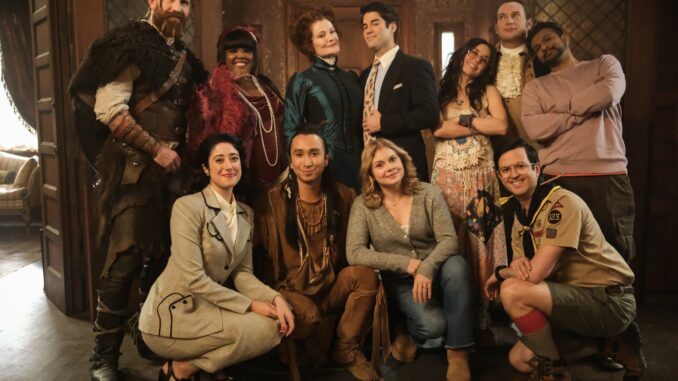
The Unseen Threshold: Why Ghosts Season 5 Must Illuminate the Path to the Afterlife
The dilapidated grandeur of Button House, home to its eccentric and anachronistic spectral residents, has charmed audiences for five seasons with its unique blend of gallows humor, heartfelt poignancy, and British eccentricity. We’ve laughed at Julian’s self-serving antics, empathized with Pat’s eternal optimism, and pondered the Captain’s repressed desires. Each ghost is a meticulously crafted character, their personalities forged from the circumstances of their death and the “unfinished business” that tethers them to the earthly plane. Yet, amidst the daily squabbles, the occasional existential dread, and the profound bonds forged between the living and the dead, there remains one monumental, lingering question, the ultimate “unfinished business” for the show itself: how, precisely, does one cross the ultimate threshold? As Ghosts enters its fifth season, it’s not just a narrative nicety; it’s an absolute necessity for the series to finally explain how spirits move on to the afterlife.
From the very first season, the concept of “unfinished business” has been the narrative scaffolding upon which the show rests. Humphrey’s missing head, Pat’s lingering connection to his family, Fanny’s misplaced will, Julian’s quest for redemption, the Captain’s unposted letters – these are the anchors keeping them from whatever lies beyond. We’ve seen glimpses of what happens when these anchors are loosened: Mary’s sudden, peaceful fading after recounting the horror of her death, and more recently, the brief, tantalizing moment where Kitty almost “moved on” after a fleeting reconnection with her long-lost sister. These instances, however, have been more flashes of consequence than clear explanations of mechanics. They offer hints of emotional closure as a catalyst, but the process itself remains shrouded in mystery, an ethereal “how-to” guide still waiting to be written.
This lacuna in the lore isn’t just a minor plot hole; it’s the fundamental existential question at the heart of the series. If the goal of every ghost, consciously or subconsciously, is to eventually find peace and move on, then the pathway to that peace becomes the most significant journey of all. To continue indefinitely without addressing this would be to reduce their centuries-long existence to an endless, ultimately meaningless waiting game. As we delve deeper into their personal histories and witness their growth – Julian learning empathy, Thomas confronting his poetic narcissism, the Captain accepting his identity – the stakes of their ultimate fates grow proportionally. We, the audience, are deeply invested in these characters; we want to see their arcs culminate in a meaningful resolution, not just an eternal status quo.
Imagine, for a moment, a scenario where the explanation unfolds. It doesn’t have to be a sudden, blinding light or a celestial being descending from the heavens, which would perhaps be too grand for Ghosts‘ understated charm. Instead, it could be a nuanced, deeply personal, and emotionally resonant process. For Julian, perhaps it’s not just an apology, but a profound understanding of the ripple effect of his actions, a genuine regret that cleanses his conscience, allowing him to feel a lightness, a pull towards an unseen warmth. We could see him, not vanish, but dissolve gently, a quiet moment of peace that signals his journey.
For the Captain, his move might be triggered by one final, significant act of leadership or protection for Button House, a moment where his strategic mind and unwavering sense of duty achieve a final, complete purpose. He might stand erect, salute the empty air, and then, with a satisfied, almost imperceptible smile, become as transparent as the historical figures he so admired, fading into the fabric of time. Pat, ever the family man, might experience his transition not through a grand reunion, but through a profound, empathic connection to his family’s continued happiness, realizing his love transcends his physical presence, allowing him to gently drift away, a spectral feather in the wind.
The beauty of such an explanation would lie in its ability to be simultaneously concrete and poetic. It could be tied to the very nature of their haunting: perhaps the act of moving on is intrinsically linked to their individual unfinished business, meaning each ghost’s departure is unique. A cosmic release, an emotional tipping point, a final act of letting go – the show has the imaginative scope to explore this without betraying its established tone.
Without this explanation, Ghosts risks leaving its viewers in a state of existential limbo, mirroring the very predicament of its characters. The charm of the Button House residents is undeniable, but their existence also carries a profound melancholic undertone. To leave the central mystery of their ultimate release unanswered would be to deny the thematic depth the show has so carefully cultivated. Season 5 is the opportune moment to provide this clarity, to complete the narrative cycle, and to offer a poignant, satisfying conclusion – or at least a significant step towards one – for the beloved spirits who have graced our screens. It’s time for Ghosts to illuminate the unseen threshold, allowing its characters, and its audience, to finally understand what lies beyond the living room.
